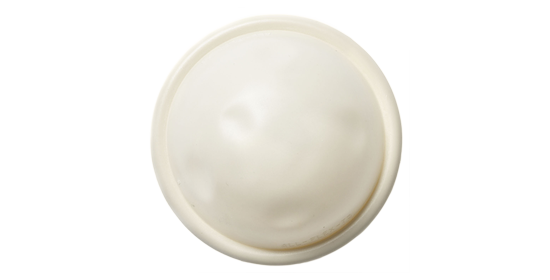A DIAPHRAGM CAN BE INSERTED JUST BEFORE SEX,
but it can also go in hours before you get to it so that it doesn’t get in the way of the moment. But no matter when it goes in, you have to be sure to leave it in for at least six hours after you have sex. If you’re going to have sex again that day, just leave the diaphragm in place and insert more spermicide way up in your vagina. Just don’t leave your diaphragm in for more than 24 hours.
BEFORE YOU PUT IT IN
Add about a teaspoon of spermicide to the inner part of the diaphragm, and spread a little of it around the rim, as well. (Not too much, or it’ll be too slippery to hang on to.) Ortho Gynol II is specifically designed for diaphragms, and comes with an applicator you can use if you’re going to have sex more than once within six hours (you’ll need to add additional spermicide). Any kind of contraceptive gel or spermicide will do, except for the film or insert/suppository types. Don’t forget to check the expiration date.
HOW TO PUT IT IN
Inserting a diaphragm may sound difficult, but with a bit of practice, it’s not so tough.
Here’s the deal:
- Wash your hands. Soap and water, no shortcuts.
- Check your diaphragm for holes and weak spots. Filling it with water is a good way to check. If it leaks, you’ve got a hole, which sort of defeats the whole purpose.
- Put a teaspoon or so of spermicide in the cup, and spread some around the rim, too.
- Get comfy, like you’re going to put in a tampon.
- Separate the outer lips of your vagina with one hand, and use the other hand to pinch the rim of the diaphragm and fold it in half.
- Put your index finger in the middle of the fold to get a good, firm grip. (And yes, you’ll be touching the spermicide.)
- Push the diaphragm as far up and back into your vagina as you can, and make sure to cover your cervix.
HAVING ANOTHER GO AT IT?
You need to leave the diaphragm in for six hours after sex. If you have sex a second time within those six hours, first insert more spermicide. (Ortho Gynol II comes with an applicator that measures how much you’ll need, and gets it where it needs to go.) Then the six-hour clock starts again, counting from the last time you have sex.
HOW TO TAKE IT OUT
Of course, what goes in must come out. Here’s how:
- Wash your hands again.
- Put your index finger inside your vagina and hook it over the top of the rim of the diaphragm.
- Pull the diaphragm down and out.
Still having trouble? Ask your doctor about getting an inserter, or consider switching to another method.
Finally, take good care of your diaphragm and it can last for several years.
- After you take it out, wash it with mild soap and warm water.
- Let it air dry.
- Don’t use powders or oil-based lubricants (like Vaseline or cold cream) on your diaphragm.
- And don’t worry if it becomes discolored. It’ll still work.
